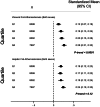Visceral adipose tissue and hepatic fat as determinants of carotid atherosclerosis
- PMID: 41107464
- PMCID: PMC12534607
- DOI: 10.1038/s43856-025-01123-y
Visceral adipose tissue and hepatic fat as determinants of carotid atherosclerosis
Abstract
Background: Visceral adipose tissue (VAT) and hepatic fat (HF) contribute to multiple health risks, including diabetes, hypertension, cardiovascular disease, cognitive decline, and cancer. The objective of this study is to determine whether VAT and HF are associated with carotid atherosclerosis beyond traditional cardiovascular risk factors.
Methods: Participants in the Canadian Alliance of Healthy Hearts and Minds (CAHHM) cohort study (n = 6760; average age= 57.1; 54.9% female) underwent MRI for VAT volume, hepatic fat fraction (HFF), and carotid atherosclerosis assessed by carotid wall volume (CWV). Regression models were used to assess the associations of VAT and HF with carotid atherosclerosis, separately in males and females, controlling for other cardiovascular risk factors. Associations of VAT and proton-density hepatic fat fraction (PDFF) with ultrasound-measured carotid-intima media thickness (CIMT) were also assessed in the UK Biobank (UKB; n = 26,547; average age = 54.7; 51.9% female).
Results: In CAHHM, we show that a 1-SD higher VAT volume is associated with a 6.16 mm³ higher CWV (95% CI: 1.68 to 10.63), but there is no association between HFF and CWV. In the UK Biobank cohort, a 1-SD higher VAT volume is associated with a 0.016 ± 0.009 mm higher CIMT, and a 1-SD higher PDFF is associated with a 0.012 ± 0.010 mm higher CIMT. After adjustment for CV risk factors, these associations are attenuated. A pooled analyses of CAHHM and UKB support a direct, positive association of VAT and HFF with subclinical atherosclerosis in both sexes, albeit slightly weaker for hepatic fat.
Conclusion: Visceral fat, and to a lesser extent, hepatic fat, are associated with increased carotid atherosclerosis.
Plain language summary
Visceral fat, a type of fat stored in the abdomen, and buildup of fat within the liver are known to increase type 2 diabetes, high blood pressure, and heart disease risk. This study aims to see how these types of fat affect artery health. We studied 6760 Canadian adults to examine how visceral and liver fat relate to the buildup of fatty plaque deposits in arteries, and 26,547 adults from the United Kingdom to see how these fats affect artery thickness. Combined results confirm that narrowed arteries and plaque buildup are strongly related to visceral fat, and to a lesser extent liver fat. These results suggest that lowering visceral fat may prevent or slow the progression of atherosclerosis.
© 2025. The Author(s).
Figures


References
-
- World Health Organization. Obesity and Overweight. https://www.who.int/news-room/fact-sheets/detail/obesity-and-overweight (2024).
-
- World Health Organization. Obesity. https://www.who.int/news-room/facts-in-pictures/detail/6-facts-on-obesity (2021).
-
- Laine, C. & Wee, C. C. Overweight and obesity: current clinical challenges. Ann. Intern. Med. 176, 699–700 (2023). - PubMed
-
- Laine, C. & Wee, C. C. Correction: overweight and obesity: current clinical challenges. Ann. Intern. Med. 176, 1016 (2023). - PubMed
LinkOut - more resources
Full Text Sources
Research Materials
Miscellaneous

